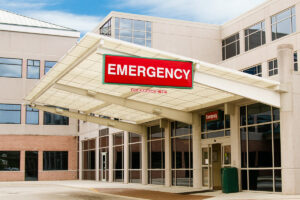What’s the Difference? Which One Is Right for You?
 When you’re hurt in an accident like a slip-and-fall or automobile wreck, you need to get immediate medical attention. But what about when you’re feeling somewhat under the weather, maybe you’re dizzy or experiencing vomiting or a fever that won’t break. Do you need to go to the emergency room? Or will you get the care you need at an urgent care facility? What’s the difference?
When you’re hurt in an accident like a slip-and-fall or automobile wreck, you need to get immediate medical attention. But what about when you’re feeling somewhat under the weather, maybe you’re dizzy or experiencing vomiting or a fever that won’t break. Do you need to go to the emergency room? Or will you get the care you need at an urgent care facility? What’s the difference?
How Do Urgent Care Facilities Differ from Hospital Emergency Rooms?
There are a number of factors that distinguish the care and services offered at an urgent facility from a hospital emergency room:
-
The severity and nature of the medical conditions treated—An urgent care facility can offer immediate relief for mild-to-moderate injuries or afflictions but won’t have the resources to treat serious injuries, such as most broken bones (anything other than simple breaks in the hand, wrist, ankle, or foot), traumatic brain injury, or serious burns. If you would normally have a condition treated by your primary care physician, but don’t want to wait for an appointment, go to an urgent care facility. For example, if you have a persistent fever or you’re having difficulty keeping food down, you could go to an urgent care facility (unless there’s a sign of something serious, e.g., blood in your vomit). Many urgent care facilities, however, have a specific list of conditions they will treat. If you are suffering from a condition not on the list, you will be sent elsewhere.
Emergency rooms are equipped to treat almost any type of medical problem. The more serious your medical condition, the better you will be served by going to an ER. While an emergency room can surely treat mild-to-moderate injuries and medical conditions, they are designed to respond to life-threatening or serious medical situations. If the matter is not serious, you may get minimal attention and be sent home.
- The day and time—Emergency rooms are open 24 hours a day, seven days a week, 365 days a year. You can get care at an ER anytime, day or night, though you may have a long wait. While most urgent care facilities are open past regular office hours, many are not open 24 hours a day. You may be able to get into some urgent care facilities as late as 11:00 p.m. or midnight but few are open later than that.
- The types of doctors and technology available—At a hospital emergency room, you’ll have access to a wide range of technologies designed to treat or respond to serious medical conditions. Most urgent care facilities have X-ray technology and can order basic lab tests but that’s about all. In addition, urgent care facilities tend to be staffed primarily with nurse practitioners, physician assistants, and nurses, whereas an emergency room will have a number of doctors on staff or on call.
The Types of Conditions Treated at Urgent Care Facilities vs. Emergency Rooms
In a hospital emergency room, you can expect to get treatment for serious and/or life-threatening injury or illness, including:
- Chest pain, heart attack, or stroke
- Pneumonia
- Broken bones other than those in the hand, wrist, ankle, or foot
- Brain or spinal cord injury, including paralysis
- Uncontrolled bleeding
- Seizures
- Serious burns
If you’re experiencing one of the following conditions, you should be fine going to an urgent care facility:
- Minor cuts or burns
- Earache, bronchitis, or upper respiratory infection
- Sprains or muscle pulls
- Broken bones in the hand, wrist, ankle, or foot
- Uncontrolled diarrhea or urinary tract infection
Contact InjuredCare.com to Connect with an Experienced Medical Professional
Contact us online or call our offices today at 866-952-7045 to learn more.

